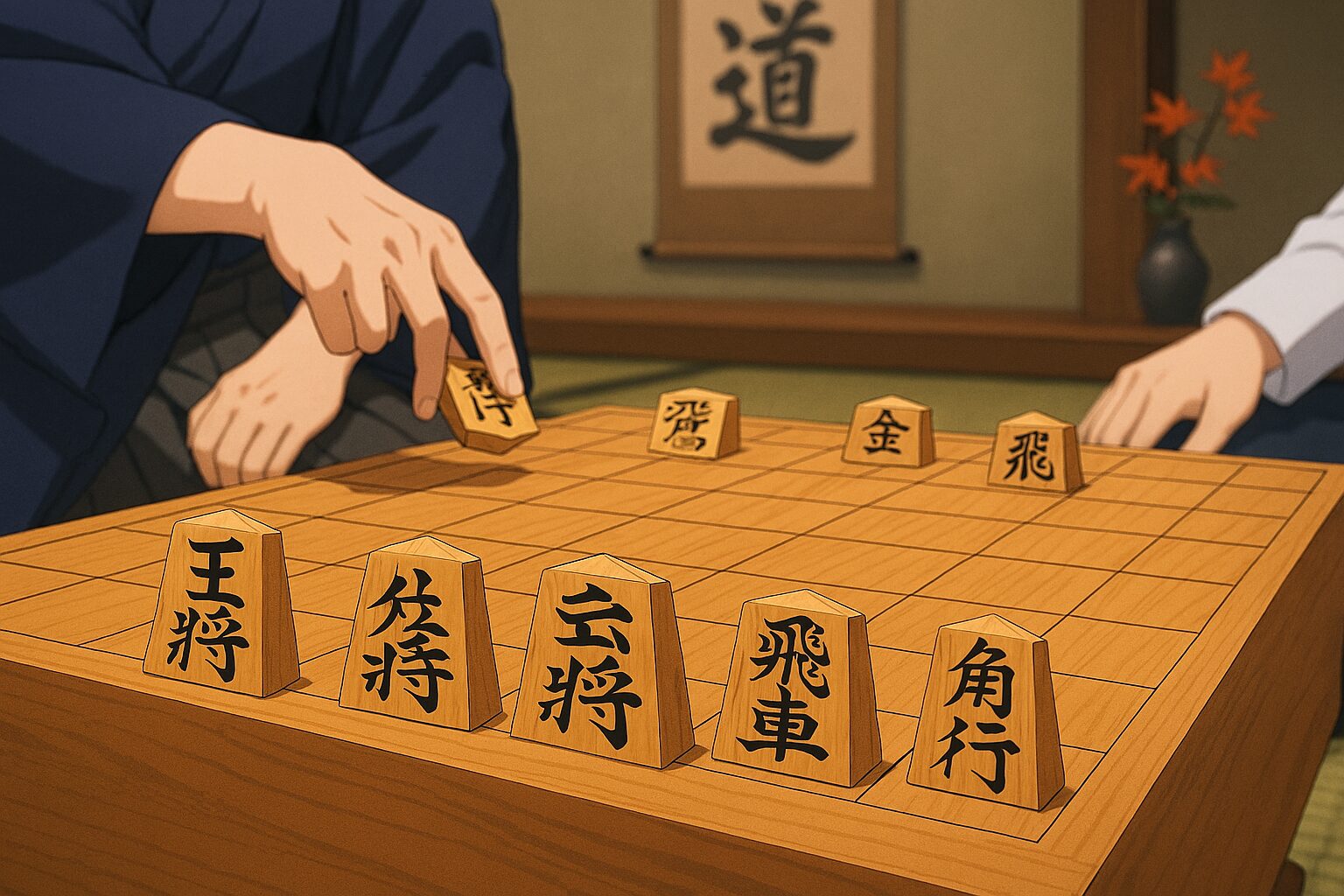November 17th. Did you know this day is celebrated in Japan as “Shogi Day“?
You might think it’s just an anniversary for a board game. However, Japanese Shogi possesses a rule so unique that it sets it apart from chess and other similar games worldwide. This rule is deeply colored by Japan’s history, strategic philosophy, and even its spiritual “Way” (Do).
Today, we use “Shogi Day” as a gateway to explore the profound spiritual culture of Japan.
The Origin of “Shogi Day”: Tokugawa Yoshimune and “Castle Shogi”
The designation of November 17th as “Shogi Day” is relatively recent, established in 1975 by the Japan Shogi Association.
But why this specific date? The origin traces back to the Edo period, during the reign of the eighth shogun, Tokugawa Yoshimune.
Yoshimune, renowned for the Kyoho Reforms, was also a deep admirer of Shogi. It is said that he institutionalized the “Oshiro Shogi” (Castle Shogi), an event where he summoned the greatest Shogi players of the time to the Edo Castle once a year—on November 17th (according to the old calendar)—to compete in his presence.
This was not only the highest honor for the players but also an intense, high-stakes battle where failure was not an option in front of the shogun. This “Castle Shogi” was a major catalyst that elevated Shogi from a mere pastime to a “Way” demanding high skill and mental fortitude.
The Defining Feature of Shogi: The “Captured Pieces” (Mochigoma) Rule
Shogi’s origins, like chess, are believed to lie in the ancient Indian game “Chaturanga.” However, after its arrival in Japan, it underwent a unique evolution. The most significant evolution was the adoption of the “Mochigoma” (captured pieces) rule.
This rule dictates that “pieces captured from the opponent can be placed back on the board as part of one’s own forces.”
This is extremely unusual among global board games. In chess, captured pieces are permanently removed from play. In Shogi, however, a soldier thought to be dead can “defect” and turn their spear against their former army.
What the “Mochigoma” Rule Symbolizes in Japanese Culture
This rule is deeply intertwined with Japanese culture.
- Bushido and the Concept of Surrender:
In Western chivalry, being captured was often seen as the ultimate shame. In Japan’s Warring States (Sengoku) period, however, sparing a competent, surrendered general and employing them in one’s own army was a common strategy. This philosophy of “re-use” rather than “disposal” of talent is famously said to be reflected in Shogi. - Endgame Drama (A Culture of Reversal):
As chess pieces are captured, the game simplifies. Shogi, however, becomes more complex as captured pieces (Mochigoma) increase. The endgame becomes more dynamic, where a single move can lead to a dramatic reversal. This resonates with the spirit of “never giving up” (resilience) or perhaps the Buddhist concept of “Mujō” (impermanence; all things must change). - The “Mottainai” (No Waste) Spirit:
Eliminating a captured piece from the game is “Mottainai” (wasteful). One could see this as an early form of the Japanese recycling spirit—using resources to their fullest extent.
Shogi as a “Do” (The Way): Etiquette and Mentality
Shogi is not just a game of winning and losing; it shares the aspect of spiritual training found in Japanese “Do” (The Way), such as Budo (Judo, Kendo), Sado (tea ceremony), and Kado (flower arrangement).
1. “Begin with Courtesy, End with Courtesy”
At the start of a match, players bow deeply and say “Onegaishimasu” (Please, let’s play). This shows respect for the opponent and humility in seeking to learn from the game. When the game ends, both winner and loser bow again, saying “Arigatou gozaimashita” (Thank you).
2. “Osho” (King General) and “Gyokusho” (Jade General)
There are two types of “King” pieces: “Osho” (King) and “Gyokusho” (Jade). They mean the same thing, so why two? A common theory states that when playing against a superior (like a teacher), it was considered rude to use the “Osho” (King). Instead, one used the “Gyokusho” (Jade), which lacks the “king” kanji’s top “dot.” This humility and respect for others (the virtue of Kenjō) is manifested even in the names of the pieces.
3. “Kansōsen” (Post-Game Review)
After the match, regardless of the outcome, the players analyze the game together (“What if you had played this move instead?”). This is the epitome of “The Way”—seeking truth beyond victory or defeat.
Shogi Living in the Modern Era
Shogi, established in the Edo period, continues to evolve today.
The emergence of young geniuses like Sota Fujii has created a national sensation.
Furthermore, we are in an unprecedented era where AI (Artificial Intelligence) has surpassed top human players, leading to a new phase where humans and AI learn from each other to create new strategies.
The tension of the “Castle Shogi” matches watched by Tokugawa Yoshimune lives on, transformed into modern title matches like the “Meijin-sen” and “Ryūō-sen.”
November 17th, “Shogi Day,” is a day for us to reflect on the history of this deep, intellectual “Way” and the unique Japanese spirit that flows beneath it.
External Links
- History of Shogi (Japan Shogi Association, Japanese)
- Details the evolution of Shogi from its origins to the present day.
Related Articles (Internal Link)
What Do You Think?
The Shogi rule of “re-using your opponent’s captured pieces.”
What kind of Japanese values do you sense in this unique system? If your country has a similar game, what aspects of your national character do you think its rules reflect?
We would love to hear your thoughts.
11月17日「将棋の日」:盤上に息づく日本の精神性と、世界唯一のルール
11月17日。この日が日本で「将棋の日」と呼ばれていることをご存知でしょうか。
単なるボードゲームの記念日、そう思うかもしれません。しかし、日本の将棋は、チェスや世界の他の類似ゲームとは一線を画す、極めてユニークなルールを持っています。そしてそのルールには、日本の歴史、戦略思想、さらには「道」の精神までが色濃く反映されているのです。
今日は、この「将棋の日」を入り口に、日本の奥深い精神文化を解き明かしていきます。
「将棋の日」の由来:徳川吉宗と「御城将棋」
「将棋の日」が11月17日と定められたのは、比較的最近の1975年のことです。これは日本将棋連盟によって制定されました。
では、なぜこの日付なのでしょうか。その起源は江戸時代、八代将軍・徳川吉宗(とくがわ よしむね)の時代に遡ります。
徳川吉宗は「享保の改革」を行った名君として知られていますが、同時に将棋を深く愛好していました。彼は、年に一度、11月17日に(旧暦)、江戸城に当代随一の棋士たちを呼び寄せ、自らの御前で対局させる「御城将棋(おしろしょうぎ)」を制度化したと言われています。
これは、棋士たちにとって最高の栄誉であると同時に、将軍の前で失敗が許されない、凄まじい緊張感を伴う真剣勝負でした。この「御城将棋」こそが、将棋が単なる遊戯から、高い技術と精神性を要求される「道」へと昇華していく大きなきっかけとなったのです。
将棋を「日本的」たらしめる最大の特徴:「持ち駒」の再利用
将棋の起源は、チェスと同じく古代インドの「チャトランガ」にあるとされています。しかし、日本に伝わった後、独自の進化を遂げました。その最大の進化こそが、「持ち駒(もちごま)」ルールの採用です。
これは、「相手から奪った駒を、自分の戦力として盤上の好きな場所に再び配置できる」というルールです。
世界のボードゲームを見渡しても、これは極めて異例です。チェスでは、取った駒は盤上から永久に退場します。しかし将棋では、死んだはずの兵士が、今度は寝返って元いた軍に牙をむくのです。
「持ち駒」が象徴する日本文化
このルールは、日本文化と深く結びついています。
- 武士道と「降伏」の概念:
西洋の騎士道では、捕虜になることは最大の恥とされました。しかし、日本の戦国時代では、降伏した有能な武将を殺さず、自軍の戦力として登用することは一般的な戦略でした。人材を「使い捨てる」のではなく、「再活用」する。この合理的な思想が、将棋のルールに反映されているという説は非常に有名です。 - 終盤のドラマ性(逆転の文化):
チェスは駒が減るほど単純化していきますが、将棋は持ち駒が増えるほど、盤面は複雑化します。終盤になればなるほど、一手で逆転が起こり得るダイナミックな展開が待っています。これは、最後まで諦めない「再起」の精神、あるいは「無常(物事は常に移り変わる)」という仏教的な思想とも通じるものがあります。 - 「もったいない」の精神:
取った駒をゲームから排除してしまうのは「もったいない」。資源を最後まで使い切る、日本のリサイクル精神の原型がここにある、と見ることもできるでしょう。
「道」としての将棋:礼節と精神性
将棋は、勝敗を競うゲームであると同時に、日本の「道(どう)」——すなわち武道(柔道、剣道)や茶道、華道と同じ精神的な修練の側面を持ちます。
1. 「礼に始まり、礼に終わる」
対局の開始時、棋士は必ず「お願いします」と深く頭を下げます。これは、相手への敬意と、この対局から何かを学ばせてもらうという謙虚さの表れです。そして対局が終われば、勝者も敗者も「ありがとうございました」と再び頭を下げます。
2. 「王将」と「玉将」
将棋のキングにあたる駒には、「王将(おうしょう)」と「玉将(ぎょくしょう)」の二種類があります。意味は同じですが、なぜ二つあるのでしょうか。
通説では、目上の人(師匠や格上の相手)と対局する際、自分が「王将」を持つのは失礼にあたるため、点のつかない「玉将」を使ったとされています。相手を立てる、日本の謙譲の美徳が駒の名称にまで現れているのです。
3. 感想戦
対局後、勝敗に関わらず、対局者同士で「あの時、こう指していたらどうなっていたか」と議論(感想戦)を行います。これは、勝敗を超えて真理を探究する「道」の姿そのものです。
現代に生きる将棋
江戸時代に確立された将棋は、現代においても進化を続けています。
藤井聡太(ふじい そうた)氏のような若き天才の登場は、日本中にフィーバーを巻き起こしました。
また、AI(人工知能)がトップ棋士を凌駕する時代となり、人間とAIが互いに学び合い、新たな戦術を生み出すという、かつてない局面を迎えています。
徳川吉宗が観戦した「御城将棋」の緊迫感は、形を変え、今や「名人戦」や「竜王戦」といったタイトルマッチに受け継がれています。
11月17日の「将棋の日」は、私たちがこの知的で奥深い「道」の歴史と、その根底に流れる日本独自の精神性に、改めて思いを馳せるための日なのです。
外部リンク
- 日本将棋連盟 (Japan Shogi Association)
- 将棋の公式ルールや、プロ棋士の活動、イベント情報を確認できます。
- 将棋の歴史(日本将棋連盟)
- 将棋の起源から現代に至るまでの変遷が解説されています。
関連記事(内部リンク)
あなたはどう思いますか?
将棋の「相手の駒を再利用する」というルール。
あなたは、このユニークなシステムに、どのような日本的な価値観を感じ取るでしょうか。もしあなたの国に似たようなゲームがあるなら、そのルールにはどのような国民性が表れていると思いますか?
ぜひ、あなたの考えを聞かせてください。


コメント